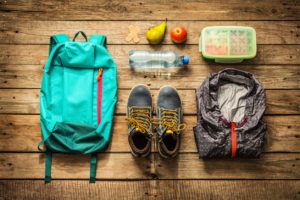Planning a family multi-day hike can be an exciting adventure. However, the trip can also cause burnout and fatigue, especially if you don’t set aside time for recovery for both the kiddos and yourself. Without adequate rest, your fun multi-day hike plan can easily become a physically exhausting trek that ruins the experience for everyone. To prepare the best multi-day hike plan, here’s everything you need to ensure everyone gets the rest and recovery they need (and have the best time!)
Why Recovery is Important for a Family Multi-Day Hike

Any type of outing can be mentally and physically demanding, even if it’s just for a few hours. As you might imagine, a multi-day hike or trip can put even more stress on your body. Without time to recover, even the most experienced of hikers can get tired and fatigued, which may increase your risk of injury. For example, you may experience:
- Muscle strain
- Joint pain
- Blisters
- Shin splints
- Poor posture
- Heat exhaustion
On top of that, resting can also help you maintain your energy and focus levels. This is especially important for kids, who may not be able to recognize their own limits until they’re too exhausted. After all, the last thing you want to have happen on your hike is for someone to slip or fall!
What Recovery Can Help With on a Family Multi-Day Hike

Resting during your hike isn’t just about taking a much-needed breather. It’s also about ensuring you’re healthy and strong for the rest of your journey. Here are a couple of physical and mental benefits of recovery time:
- Repair muscle tissue
- Prevents injuries
- Increases energy and mental clarity
- Boost mood
- Promotes better sleep quality
Recovery Time by Age

Kids and teens have different needs than adults, especially when it comes to recovery time. Even then, it’s important to note that they may recover at a different pace than other people their age. Therefore, it’s crucial to develop a recovery plan that works specifically for you and your child. To help you can use these general guidelines of recommended recovery times by age.
- Toddlers (under 6 years old) – Multi-day hikes can be strenuous for young kids, so it’s best to stick to short walks or day trips. This is true even if you have a child carrier. But, if you are on a multi-day hike, you’ll want to take frequent breaks every 30 minutes. It can also be beneficial to have a day or two of rest in between the hike for kids to play and focus on other activities.
- Children (6 to 12 years old) – Some children may do well on a multi-day hike. However, you should be taking breaks every hour and limiting your hike to just a few hours a day. It’s also a good idea to have one full rest day every two or three days while you’re out and about.
- Teens (13 to 18 years old) – Teens generally have the same recovery time as adults, although they tend to need more sleep and water. While they don’t need as many frequent breaks, taking a day for rest can prevent fatigue and help with muscle recovery.
7 Tips for Creating a Perfect Family Multi-Day Hike Plan

With a little preparation, you can ensure that everyone is prepared for their family multi-day hike. Consider these 7 tips when creating your family multi-day hike:
1. Start and End with Stretching
A few minutes of leg and back stretches can help with long-distance journeys. It can prepare your muscles, promote circulation, and prevent soreness that comes with hiking or walking. Because of this, including a few minutes of stretching time to your multi-day hike plan agenda is crucial.
2. Drink Water and Stay Hydrated
Staying hydrated is one of the most important tips for anyone embarking on an outdoor adventure. After all, your muscles can’t properly function or recover unless they have enough water! Every hiker should drink in the morning and have their own water bottle for the trip.
3. Eat Healthy, Nutritious Foods
Our bodies need nutrients to sustain themselves on a multi-day hike. Therefore, you’ll want to make sure you’re getting enough protein, carbs, and healthy fats. Healthy snacks (like nuts, dried fruits, and jerky) can also provide fuel in between meals. Stock your backpack with some snacks for everyone on the trip – you won’t regret including this in your family multi-day hike plan.
4. Plan for a Recovery Day
A midday pause or lunch break is great for recovery. If you’re hiking for several days at a time, you should set aside a full day for rest. While you don’t have to be completely inactive, you can use this free day to explore other sights or simply enjoy being outdoors.
5. Bring a First Aid Kit
Even with sufficient recovery, it’s still best to be prepared for accidents and injuries. Keep a first aid kit on you at all times, and make sure it’s stocked with bandages, medicine, and things for wound care so you’re prepared if disaster strikes.
6. Wearing Appropriate Hiking Clothes
What you wear can also impact your hiking experience. Bring breathable layers to help you stay dry and cool, or warm layers if it’s chilly outside. Wear padded socks to prevent blisters and foot pain, and invest in a pair of comfy hiking shoes that can withstand any type of terrain or outdoor element.
7. Be Flexible
Traveling with kids almost never goes according to plan. This is especially true on hikes, where fatigue and exhaustion can easily take over. If someone gets tired or needs extra rest, it’s okay to deviate from your original plans. At the end of the day, it’s not about the destination. It’s about spending time with family and loved ones and ensuring that everyone is having a good time!
Taking your kids on a family multi-day hike can be a wonderful experience, as long as you’re prepared to rest when needed. This can be said for any long-term family trip you’re taking! If you’re looking for other budget-friendly vacation ideas, here are some exciting places to travel to. And you can save even more money with these budgeting tips created specifically for families.






